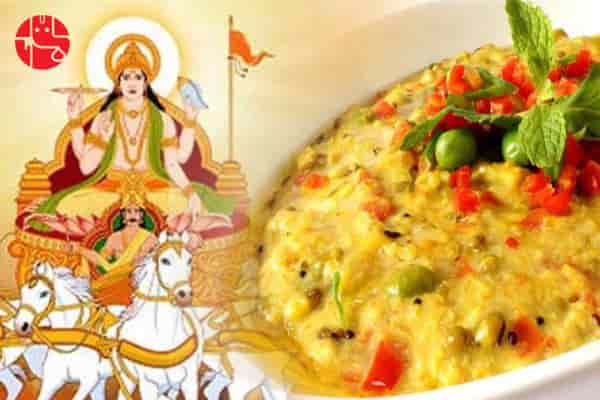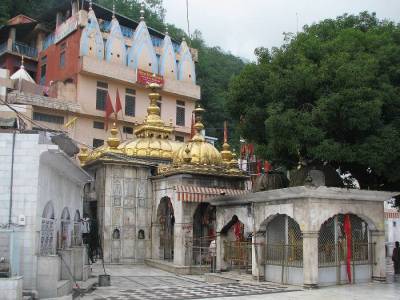🍛 KHICHDI 🍛
Khichdi one of the most basic dishes cooked in any household. It's a simple, classic, single-pot, easy to cook wholesome meal which is not only appetising to the taste buds, but has the perfect balance of nutrients too.

The country where festivals are celebrated by eating variety of dishes, who would have thought that this humble Khichdi became one of the important foods with which the festival of Makar Sankranti is celebrated. In fact, the humble khichdi is so integral to the festivities that Makar Sankranti is alternatively called 'Khichdi' in some regions of the country.
So, read this further to know answers of following questions:-
- Why Khichdi is synonymous with the festival of Sankranti? OR How the festival of Makar Sankranti came to known as Khichdi festival?
- What is the significance of khichdi during the festival and how is it relevant?
- What are the Scientific and other Reasons behind eating Khichdi?

☘Religious Significance
✒ On Makar Sankranti there is a tradition of making new rice khichdi as prasaad to Surya Devta(Sun God) and Kul Devta (Clan God/Gods). People send Khichdi to each other's house and wish for peace and happiness.
.

One reason behind this practice is that India is an agricultural country and Sun God has been considered as the basis of agriculture & thus make Khichdi to offer it to the Surya Dev.
✒ It is also believed that the tradition of making khichdi started from Gorakhpur in Uttar Pradesh on the day of Makar Sankranti. This is the reason why Makar Sankranti is also known as 'Khichdi' festival in Uttar Pradesh.
Baba Gorakshnath was the initiator of the tradition of Khichdi.It is said that Khichdi was the favourite food of the Hindu god Gorakshnath, a Hindu yogi, saint who was the influential founder of the Nath Hindu monastic movement in India. He is also considered as part of Lord Shiva. That's why the tradition started by him continued to play
✒ The story of Khichdi of Gorakhnath of Gorakhpur starts from the mother and that mother is not an ordinary mother. He is the form of Adishakti. Although no mother is ordinary , but this mother is fulfilling the promise given to her son.

According to belief, one day while wandering, AdiGuru Gorakshanath reached the place of Goddess Jwala Devi in Kangra district of Himachal Pradesh during the Treta era. When he reached the beautiful, spiritual and picturesque place, he had a divine feeling.
Seeing the Siddha Yogi, Maa(Goddess) Jwala herself appeared and addressed Guru Gorakshnath as son. Baba also felt blessed to have sight of Maa Jwala before him. Mother invited him for food and told him to get purified first, till then she serve food. When the Guru arrived, he politely refused to eat the Tamasa food (variety of dishes present there) and said to have food made with only rice and pulses, which he received in alms.
The Goddess respected the Guru's wish and said that I will serve food made from rice and pulses brought by you. The Goddess set fire to the pot to make it, and the Guru left for asking alms. From there he came to place Gorakhpur, and here, after choosing a place at the confluence of Rapti and Rohini rivers, he kept his Akshay Patra (never ending vessel) at one place and became absorbed in spiritual practice.

Gorakhnath Temple: Baba Gorakshanath
At the same time when the festival of Makar Sankranti came, people saw the Akshay Patra of the saint (Yogi), then they started adding rice and dal into his vessel. When the vessel was not filled even after adding a lot of food, people considered it a miracle of Yogi and bowed his head in reverence before him. The tradition of offering rice and pulses at Gorakhanath's Taposthali, which started then is still going on with same faith and reverence. Hence the name placed Gorakhpur.
1

Gorakhnath Temple: People offering Khichdi
✒ Since then, every year in the Gorakhanath temple, Khichdi is offered to idol of AdiGuru Gorakshnath first by Gorakshapeethaadheeshwar (head of Gorakshapeeth) at dawn, then Khichdi from King of Nepal & then brought by other devotees, after which the process continues till late evening. Devotees throng the temple and offer Baba Gorakhnath rice, lentils and haldi and seek blessings for a prosperous harvest year ahead. Khichdi is then served to all the devotees present at the temple as a 'prasada' or blessing from god.It is believed that Guru Gorakhnath fulfills every wish of devotees who offer khichdi to him on Makar Sankranti.
✒On the other hand, in the 'Jwala Devi Temple', situated amidst Kalidhar hill in Kangra district of Himachal Pradesh which is considered one of the 51 Shakti Peethas of the Goddess, where the tongue of Mother Sati fell after getting cut down by Sudarshan Chakra of Lord Vishnu, it is said that even after all these years, water is still boiling for preparing food for Guru Gorakshanath.

Jwala Devi Temple, Kangra
This place is called Gorakhdibbi where Mother Goddess Jwala Devi is still waiting for her son's return. On the day of Makar Sankranti, devotees arrive with khichdi in Kangra at Jwala Devi Temple.

Devi in the form of Jwala
(Believed to be Mouth of Goddess Mahakali)
✒ They hang rice and potatoes etc. wrapped in a cloth above. the place and it got boiled due to the effect of Gorakhdibi water. It is a divine miracle that if one takes out the water from that Dibbi in his/her hand, it feels cold, but hot in that Dibbi.

JwalaDevi Temple: Gorakhdibbi
☘ Historical Significance
✒ The legend is that during the invasion of the Muslim ruler Khilji, the Nath yogis(saints) could not get the time to cook food due to the struggle with Khilji. This often left yogis hungry and weakened.
To solve this problem, Baba Gorakhnath advised to cook dal, rice and vegetable together. This dish was quite nutritious and delicious too. It also provided immediate energy to their bodies. Nath yogis liked this dish a lot. Baba Gorakhnath named this dish Khichdi.
With the quick-cooked khichdi, the food problem of Nath yogis was solved and he was successful in removing the terror of Khilji. Makar Sankranti is also celebrated as Vijay Darshan festival in Gorakhpur due to the freedom from Khilji.
✒ A Khichdi fair starts on the day of Makar Sankranti near the temple of Baba Gorakhnath, situated at Gorakhpur. Khichdi is offered to Baba Gorakhnath in this fair that lasts for several days and is also distributed as Prasaad.
☘ Cultural Significance

✒ Makar Sankranti is a special harvest festival of the North and is celebrated by preparing several types of dishes. Khichdi, the one pot meal is usually made with freshly harvested rice, lentils and a mélange of Indian spices with winter vegetables, which makes it a special dish. This signifies the process of life and regeneration, which further indicates the beginning of the new harvest year Since the dish is cooked in a single pot, it is symbolic of unity.
☘ Scientific Reasons Behind Eating Khichdi
✒ Since the celestial transition during this time results in longer and warmer days, there is a change in temperature levels. This change of season results in many health-related issues. Therefore, it is imperative to consume a diet that is well-balanced, nutritious and light at the same time same time. Khichdi happens to be one vegetarian delight, which is light on the stomach, so easily digestible. The ingredients of this dish help in boosting our immunity and also keeps body warm from within which is quite important during the chilly days.
☘ Nutritional Value of Khichdi

✒ Khichdi is the wholesome meal fully packed with nutrition. The combination of rice, lentils and ghee provides carbohydrates, proteins, dietary fibre, Vitamin C, calcium, magnesium, phosphorus and potassium to our body. Many people also add vegetables to it to enhance its nutritional value.
☘ Ayurvedic Significance
✒ Khichdi is a staple food of the Ayurvedic diet, as it has the ability to balance all the three doshas - Vatta, Pitta and Kapha, making it a tridoshic food. Apart from calming the body and detoxifying it is nutritionally dense too which helps to improve energy, immunity and digestion. Rice is considered as the moon in Ayurveda.
☘ Importance in Scriptures

✒ In the Scriptures, Rice is considered a symbol of the moon. Similarly Kali Urad Dal is considered a symbol of Saturn and Salt is considered a symbol of Venus. Turmeric is the symbol of Jupiter. Green vegetables belongs to Mercury. The heat of Khichdi connects the person to Mars and the Sun. In this way, eating the Khichdi makes all the major planets strong. It is believed that the body remains healthy for the whole year by eating Khichdi of new grains on the day of Makar Sankranti.
This is all about Khichdi's relation to the festival of Makar Sankranti. Hope you enjoy reading Khichdi story too😊
Edited by kavya1994 - 4 years ago

, only described the first one in detail as it was important to know what kind of relationship Sun God & Lord Shani share to understand this day's astrological, religious & cultural significance.















































37